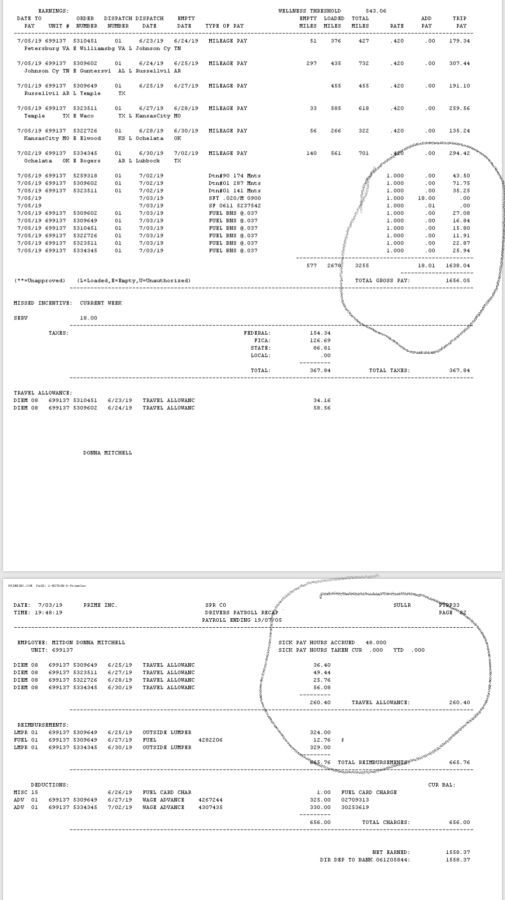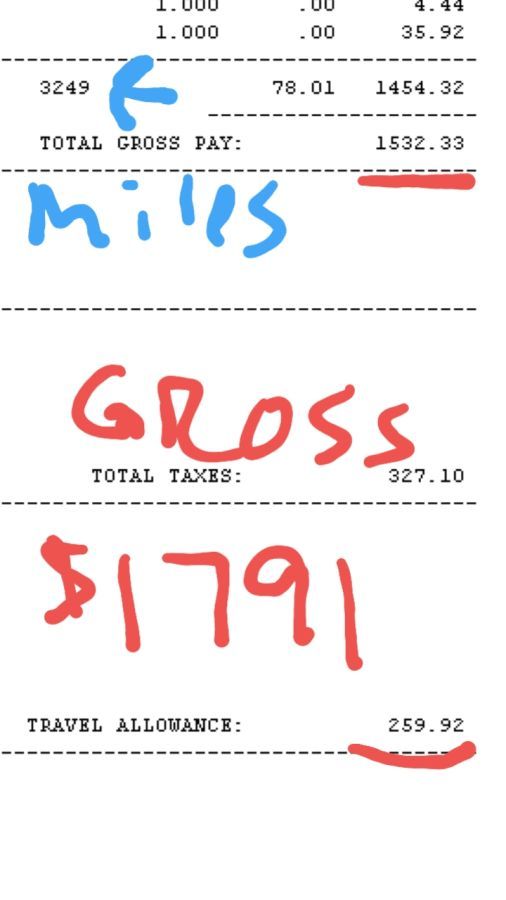Rick C... Here's Why I Don't Focus On Detention Pay
Topic 26063 | Page 1
I didn't want to keep stealing the other thread
This week I ran 3249 miles.
My pay rate is 48 cpm plus bonuses. Including detention, fuel and safety bonuses I came to 55cpm.
For a grand total of $1791 Gross I put $229 into my 401k and $100 into an AMEX high yeild savings account so $1215 got deposited into my bank.
It is more about clock management and availability than cpm and bonus/detention. It is all about getting the load early, planning down time, and making sure you have hours on your 70 to get loads assigned.
Even with these high miles, I got a 34 over 4th of July, picked up a load where i was told to stop 3 hours later as the shipper and receiver fought over case counts which killed.my 14 clock. and shut down 8 hours for a tornado in Kansas.
In the left corner is the miles. For my gross you add the gross plus travel allowance (per diem) for my total gross pay.
This check is awesome and actually as good as many teams do if not more.
You go girl!

Shipper:
The customer who is shipping the freight. This is where the driver will pick up a load and then deliver it to the receiver or consignee.
CPM:
Cents Per Mile
Drivers are often paid by the mile and it's given in cents per mile, or cpm.
Per Diem:
Getting paid per diem means getting a portion of your salary paid to you without taxes taken out. It's technically classified as a meal and expense reimbursement.
Truck drivers and others who travel for a living get large tax deductions for meal expenses. The Government set up per diem pay as a way to reimburse some of the taxes you pay with each paycheck instead of making you wait until tax filing season.
Getting per diem pay means a driver will get a larger paycheck each week but a smaller tax return at tax time.
We have a ton of information on our wiki page on per diem pay
Def all about trip planning time management and hard work my checks look very similar every week and i get to spend every weekend at home Ps to the new drivers you earn this kinda miles and paychecks dont expect them right out of training
It is more about clock management and availability than cpm and bonus/detention. It is all about getting the load early, planning down time, and making sure you have hours on your 70 to get loads assigned.
This is another of the key points we try to help people understand, and all of the top earning drivers will agree with this. You put yourself at the top of the leaderboard for earnings in your fleet by putting yourself at the top of the leaderboard for average miles turned each week. It's as simple as that.
If you're not turning 3,000 or more miles per week then you're simply not using your available hours efficiently. You're leaving money on the table. Now if you're a new driver with less than six months experience you shouldn't be shooting for numbers that high. You should be looking for about 2,500 miles per week on average. It takes time to learn to use your clock efficiently and to let your body adjust to the rigors of life on the road.
It's all about performance. Turn big miles and you'll make big money. Sitting for a few hours at the docks is a great opportunity to catch a nap and catch up on some little things. Don't sweat it.
CPM:
Cents Per Mile
Drivers are often paid by the mile and it's given in cents per mile, or cpm.

Good post, Rainy. Imo you have the right attitude for OTR. I look forward to mining your previous posts and reading the new.
Agree entirely about the importance of trip planning and time management. I'm counting on those to make my second go at driving much more interesting, healthier, and yes, profitable.
Perhaps a lot of drivers who could and would (and did) drive 5000 miles or more a week resent the tighter regulations and lower pay, I read that many are leaving trucking for that reason. But one has to admit that those rules, among other things, level the field for people with less stamina, and lives to live. It's another reason for new people to consider and reconsider driving as an occupation, and I say that confidently because it is one of my reasons.
OTR:
Over The Road
OTR driving normally means you'll be hauling freight to various customers throughout your company's hauling region. It often entails being gone from home for two to three weeks at a time.
Dm:
Dispatcher, Fleet Manager, Driver Manager
The primary person a driver communicates with at his/her company. A dispatcher can play many roles, depending on the company's structure. Dispatchers may assign freight, file requests for home time, relay messages between the driver and management, inform customer service of any delays, change appointment times, and report information to the load planners.HOS:
Hours Of Service
HOS refers to the logbook hours of service regulations.If you're not turning 3,000 or more miles per week then you're simply not using your available hours efficiently. You're leaving money on the table. Now if you're a new driver with less than six months experience you shouldn't be shooting for numbers that high. You should be looking for about 2,500 miles per week on average. It takes time to learn to use your clock efficiently and to let your body adjust to the rigors of life on the road.
Unfortunately it is becoming harder to get 3000 consistently.
1.) My loads are getting tighter and tighter on time frames I have way less opportunity to get 34's while loaded than I used to. While many argue they do 8 to 9 hours per day for the recaps, My loads don't allow that. Because of this I don't always have the "get there 10 hours early and break" option. Also, i don't get time between loads so it is rush from one to the other, then rush out. less planning and more rushing.
2.) The elogs are indeed taking effect, causing more and more parking issues earlier in the day. I have been to trucks stops and rest areas that are completely full even at noon. You can no longer "creep" around customers as easily. Mine trips for the slightest things, and occasionally it will force me to do another 30 min break of i dont watch it carefully.
3.) The mantra "We discourage company drivers from taking 34's" is becoming more popular. If I say I am taking a 34, i get "10/4". if a new driver does, he may get some resistence. So if a driver has 2 hours left on their 70, and is only getting back 3 hours that night, they will give him a 200 mile load. IMO that wastes 2 days. In their opinion, it is building the 70 back up.
4.) Shuttle drivers are becoming more popular such as Swift and that Falcon that went under. The load may be 1200 miles, but the OTR driver relays it between local shuttle drivers at both ends. So the OTR guy may get only 700 or 800 of that 1200 mile load.
5.) Teams are getting loads I used to get as a solo driver. Yes they are getting it to drop yards faster, but the solo drivers are now running the last few hundred miles instead of the whole load. However, when I team, my loads are still tight as heck. My friend TNT trainer and I had the same load going from the same shipper to same receiver at the same pick up time. He had enough time to get a 34, they only gave me 7 hours leeway for breaks fueling etc. I laughed and told him that is cause i am better lol With teaming i always feel like i am chasing a dangling carrot. I get to Cali with 2500 miles for an awesome week, then a 3 stop pick up delays me for two days. By the time i deliver, i am.past the pay cut off. That means as a team, i have gotten less miles than when i am solo. Then i chase the next weeks miles.
6.) The average length of my loads has dropped significantly. My average loads used to be 1000 miles. Now it is more like 700. More time sitting in docks.
7.) Less customers/local towns are allowing parking.
8.) More dedicated routes are getting the 3000 miles. At Prime that requires a lightweight and specific geograhical location.
My last trainee (5 mos solo) is getting 2500 on a bad week and 2900 on a good. I have been getting 2200 on my home weeks, and 2800 to 3000 normally
Elog:
Electronic Onboard Recorder
Electronic Logbook
A device which records the amount of time a vehicle has been driven. If the vehicle is not being driven, the operator will manually input whether or not he/she is on duty or not.
Elogs:
Electronic Onboard Recorder
Electronic Logbook
A device which records the amount of time a vehicle has been driven. If the vehicle is not being driven, the operator will manually input whether or not he/she is on duty or not.
Shipper:
The customer who is shipping the freight. This is where the driver will pick up a load and then deliver it to the receiver or consignee.
Dedicated Route:
A driver or carrier who transports cargo between regular, prescribed routes. Normally it means a driver will be dedicated to working for one particular customer like Walmart or Home Depot and they will only haul freight for that customer. You'll often hear drivers say something like, "I'm on the Walmart dedicated account."
OTR:
Over The Road
OTR driving normally means you'll be hauling freight to various customers throughout your company's hauling region. It often entails being gone from home for two to three weeks at a time.
OWI:
Operating While Intoxicated
TNT:
Trainer-N-Trainee
Prime Inc has their own CDL training program and it's divided into two phases - PSD and TNT.
The PSD (Prime Student Driver) phase is where you'll get your permit and then go on the road for 10,000 miles with a trainer. When you come back you'll get your CDL license and enter the TNT phase.
The TNT phase is the second phase of training where you'll go on the road with an experienced driver for 30,000 miles of team driving. You'll receive 14¢ per mile ($700 per week guaranteed) during this phase. Once you're finished with TNT training you will be assigned a truck to run solo.
Very nice Rainy and that goes to show those that gripe about being governed even at 62 mph you make great money and plenty miles. I average about 2850 miles weekly, my high was 3700 and I take a 34 EVERY weekend. I like my relax time to do laundry, shower etc and just unwind but mostly my DM schedules me through Saturday but weekend dispatch is not so good at getting us loads so I 34 Sunday to Monday morning when my DM gets in regardless how much time I have on my 70 cause it's easier than the aggravation of trying to get a load from weekenders however i run pretty hard so not usually much time left. I do however feel like I waste a lot of time sitting at shippers and receivers. I will have a load within 15 minutes of my DM getting in on Monday morning so that's always nice.
Shipper:
The customer who is shipping the freight. This is where the driver will pick up a load and then deliver it to the receiver or consignee.
Dm:
Dispatcher, Fleet Manager, Driver Manager
The primary person a driver communicates with at his/her company. A dispatcher can play many roles, depending on the company's structure. Dispatchers may assign freight, file requests for home time, relay messages between the driver and management, inform customer service of any delays, change appointment times, and report information to the load planners.HOS:
Hours Of Service
HOS refers to the logbook hours of service regulations. Thought I posted this but...
Rainy u out done me last week, but I gave it a good try.. rookie or not u got to run hard!
Thought I posted this but...
Rainy u out done me last week, but I gave it a good try.. rookie or not u got to run hard!
New Reply:
New! Check out our help videos for a better understanding of our forum features

















Preview:









 TT On Facebook
TT On Facebook
I didn't want to keep stealing the other thread
This week I ran 3249 miles.
My pay rate is 48 cpm plus bonuses. Including detention, fuel and safety bonuses I came to 55cpm.
For a grand total of $1791 Gross I put $229 into my 401k and $100 into an AMEX high yeild savings account so $1215 got deposited into my bank.
It is more about clock management and availability than cpm and bonus/detention. It is all about getting the load early, planning down time, and making sure you have hours on your 70 to get loads assigned.
Even with these high miles, I got a 34 over 4th of July, picked up a load where i was told to stop 3 hours later as the shipper and receiver fought over case counts which killed.my 14 clock. and shut down 8 hours for a tornado in Kansas.
In the left corner is the miles. For my gross you add the gross plus travel allowance (per diem) for my total gross pay.
This check is awesome and actually as good as many teams do if not more.
Shipper:
The customer who is shipping the freight. This is where the driver will pick up a load and then deliver it to the receiver or consignee.
CPM:
Cents Per Mile
Drivers are often paid by the mile and it's given in cents per mile, or cpm.
Per Diem:
Getting paid per diem means getting a portion of your salary paid to you without taxes taken out. It's technically classified as a meal and expense reimbursement.
Truck drivers and others who travel for a living get large tax deductions for meal expenses. The Government set up per diem pay as a way to reimburse some of the taxes you pay with each paycheck instead of making you wait until tax filing season.
Getting per diem pay means a driver will get a larger paycheck each week but a smaller tax return at tax time.
We have a ton of information on our wiki page on per diem pay